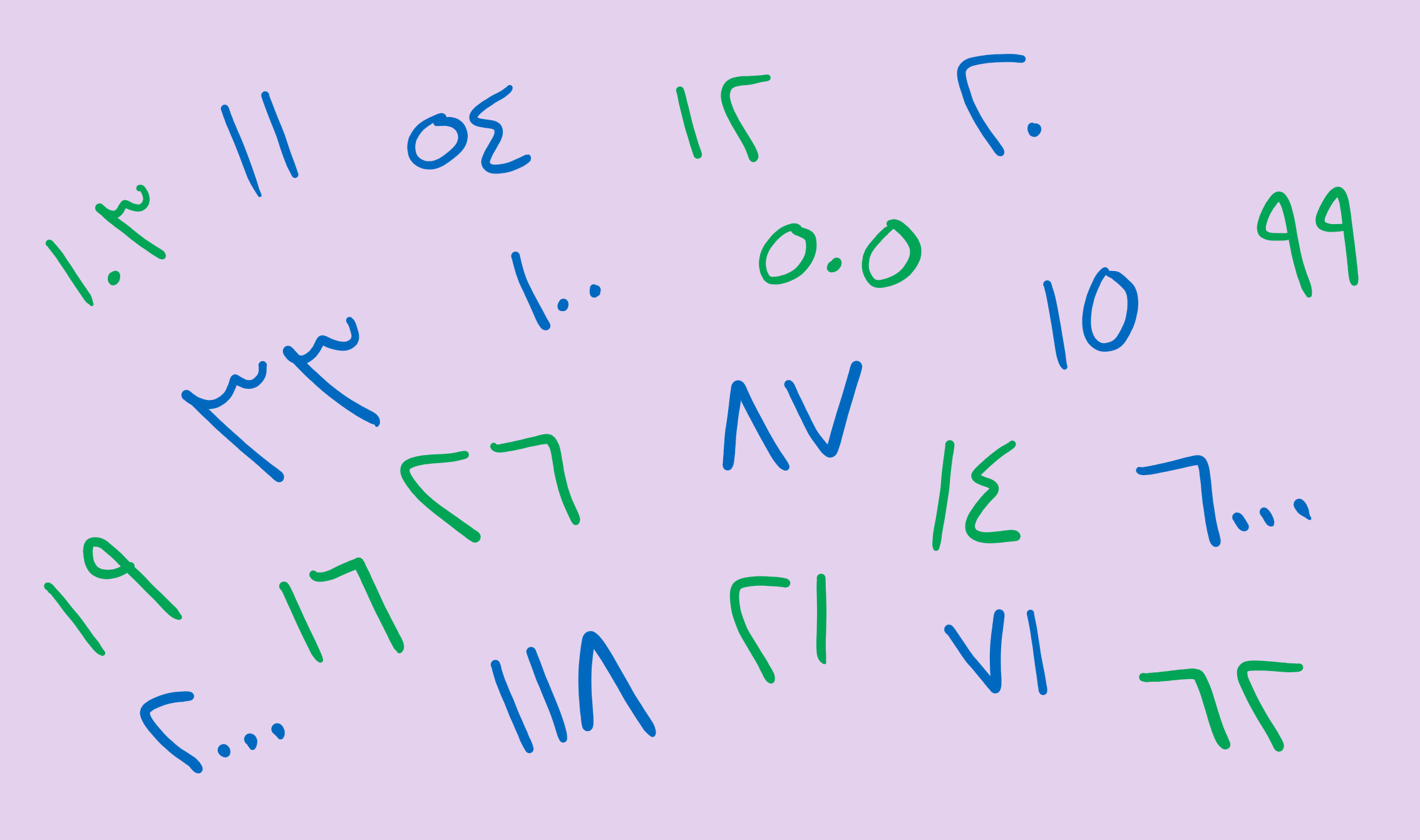Dealing with Arabic Numbers Part Two Posted by yasmine on Apr 28, 2021 in Arabic Language, Numbers
In the previous post, we covered الأرقام numbers (واحِد إلى عَشرة (١٠–١. In this post, we’ll be continuing on from 11 and beyond.
Before we begin, take a look at the random numbers below, which ones can you make out?
الأرقام من أحدَ عَشَر إلى تِسْعَة عَشَر (١١–١٩)
Numbers ١١ to ١٩ share a common element, that being عَشَر. The pattern for numbers ١٣ to ١٩ is exactly the same, for example: ثلاثة عشر being the feminine form and ثلاث عشر being the masculine. Just like numbers ١ and ٢, there is a slightly different pattern for numbers ١١ and ١٢. Instead of saying واحد عشر and اثنان عشر, we say أحد عشر (masculine) إحدى عشرة (feminine) and إثنا عشر (masculine) and اثنتا عشرة (feminine).
Rule for numbers ١١ and ١٢:
Remember that these numbers consist of two parts: the first being أحد /إثنا and the second being عشر. Both parts AGREE with the gender of the noun which comes AFTER the number.
For example:
أحد عشر رجلاً واثنا عشر رجلاً
إحدى عشرة بنتاً واثنتا عشرة بنتاً
Rule for numbers ١٣ to ١٩:
The first part of the number DISAGREES with the gender of the noun while the second part عشر AGREES with the gender of the noun which comes AFTER the number.
For example:
ثَلاثَةَ عَشَرَ دَرْسًا
خَمْسَ عَشْرَةَ تفاحَة
الأرقام من عشرون إلى تِسْعَة وتِسعون (٢٠–٩٩)
When it comes to the tens, just as English adds the suffix -ty to the root numbers to make for example forty, Arabic adds ون – to make أَرْبَعُونَ. These numbers have no feminine forms, Therefore, 60 boys is ًستونَ ولدا and 60 girls is ًستونَ بنتا.
When making numbers such as ٢١٫٠٤٥٫٣٧ remember that in Arabic, we pronounce the additional number before the tens number unlike English. For example, in English we say “twenty three” whereas Arabic says “three and twenty” ثلاثة وعشرون.
Rule for numbers ٢٠ to ٩٩:
Since the tens number does not have a feminine form, we look at the first part of the number which DISAGREES with the gender of the noun which comes AFTER the number.
For example:
خمسة وعشرون رجلاً
خمس وعشرون بنتاً
١٠٠ مِئَة and ١٠٠٠ ألف
One hundred in Arabic is مِئَة and one thousand is ألف. To say 200 or 2000 we use the dual making مِئَة into مِئَتَان and ألف into ألفين. We keep the same form for masculine and feminine nouns. مِئة رَجُل, ألف بِنت.
The order in which we say numbers such as 103 is the same as in English مِئَةٌ وَ وثلاثة.
The rule here is that the last word in the number will agree or disagree in gender and the noun will either be in singular or plural form depending on that last word in the number.
For example, one hundred and five boys is مِئَةٌ وَ خمسة اولاد. Here خمسة is the last word in the number. Since 3-9 disagree in gender and are followed by the plural noun, the noun is in the plural form and خمسة is in the feminine form since it must disagree in gender.
Let’s look at another example, one hundred and seventy-three boys is مِئةٌ وَ ثَلَاثَةٌ وَ سبعون وَلَداً. Here سبعون is the last word which does not change regardless of the noun’s gender, but is followed by a singular noun making it ًولدا instead of اولاد.
✨More examples:
ألف دينارٍ
one thousand Dinars
مِئة عام
one hundred years
.حَضَرَ ثلاثةٌ وعشرون طالباً
Twenty-three students attended.
.عندي مِئة وثمانيةٌ وسبعون كتاباً، وثلاث وأربعون رِسالة
I have one hundred and seventy-eight books, and forty-three letters.
حَضَرَ إلى المُدَرَج ثلاثمئة وأحد عشر طالباً، وتسع وتسعون طالبة، واستمعوا إلى خمس مواد، كل مادة ساعتان، وامضوا في الكلية إحدى عشرة ساعة
Three hundred and eleven male students and ninety-nine female students came to the auditorium, listened to five subjects, each subject for two hours, and spent eleven hours at the college.
✨Here are examples of numbers in Quranic verses.
وَإِلَـٰهُكُمْ إِلَـٰهٌ وَاحِدٌ ۖ لَّا إِلَـٰهَ إِلَّا هُوَ الرَّحْمَـٰنُ الرَّحِيمُ
“And your god is one God. There is no deity [worthy of worship] except Him, the Entirely Merciful, the Especially Merciful.” [2:163]
اللَّـهُ الَّذِي خَلَقَ سَبْعَ سَمَاوَاتٍ وَمِنَ الْأَرْضِ مِثْلَهُنَّ
“It is God who has created seven heavens and of the earth, the like of them…” [65:12]
إِذْ قَالَ يُوسُفُ لِأَبِيهِ يَا أَبَتِ إِنِّي رَأَيْتُ أَحَدَ عَشَرَ كَوْكَبًا
“When Yusuf said to his father: O my father! Indeed I saw in a dream eleven stars…” [12:4]
✨After reviewing all these number rules while trying to phrase them as simply and clearly as possible, I realized that no matter what, if you wish to use Arabic numbers in their grammatically correct forms, you’d have to carefully study these rules, which takes some effort. As I mentioned in the previous post, it depends on how deep you want to go. You may be at a stage in your Arabic learning, where just knowing the Arabic numbers and the correct order in which to say them is enough. Or, you enjoy knowing the exact rules and how they are used in for example Quranic verses or scholarly texts. In any case, I hope these posts helped in at least giving you an idea of how Arabic numbers work.
Till next week, happy Arabic learning! ?

Build vocabulary, practice pronunciation, and more with Transparent Language Online. Available anytime, anywhere, on any device.





Comments:
Mohd Razib Bin Nordin:
Thank you for sharing . An excellent post.